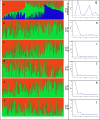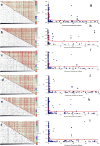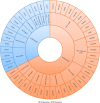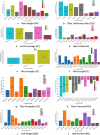Integration of conventional and advanced molecular tools to track footprints of heterosis in cotton
- PMID: 30373509
- PMCID: PMC6206862
- DOI: 10.1186/s12864-018-5129-4
Integration of conventional and advanced molecular tools to track footprints of heterosis in cotton
Abstract
Background: Heterosis, a multigenic complex trait extrapolated as sum total of many phenotypic features, is widely utilized phenomenon in agricultural crops for about a century. It is mainly focused on establishing vigorous cultivars with the fact that its deployment in crops necessitates the perspective of genomic impressions on prior selection for metric traits. In spite of extensive investigations, the actual mysterious genetic basis of heterosis is yet to unravel. Contemporary crop breeding is aimed at enhanced crop production overcoming former achievements. Leading cotton improvement programs remained handicapped to attain significant accomplishments.
Results: In mentioned context, a comprehensive project was designed involving a large collection of cotton accessions including 284 lines, 5 testers along with their respective F1 hybrids derived from Line × Tester mating design were evaluated under 10 diverse environments. Heterosis, GCA and SCA were estimated from morphological and fiber quality traits by L × T analysis. For the exploration of elite marker alleles related to heterosis and to provide the material carrying such multiple alleles the mentioned three dependent variables along with trait phenotype values were executed for association study aided by microsatellites in mixed linear model based on population structure and linkage disequilibrium analysis. Highly significant 46 microsatellites were discovered in association with the fiber and yield related traits under study. It was observed that two-thirds of the highly significant associated microsatellites related to fiber quality were distributed on D sub-genome, including some with pleiotropic effect. Newly discovered 32 hQTLs related to fiber quality traits are one of prominent findings from current study. A set of 96 exclusively favorable alleles were discovered and C tester (A971Bt) posited a major contributor of these alleles primarily associated with fiber quality.
Conclusions: Hence, to uncover hidden facts lying within heterosis phenomenon, discovery of additional hQTLs is required to improve fibre quality. To grab prominent improvement in influenced fiber quality and yield traits, we suggest the A971 Bt cotton cultivar as fundamental element in advance breeding programs as a parent of choice.
Keywords: Cotton; Favorable alleles; Fiber quality; GCA; Heterosis; L × T; Microsatellite markers; SCA; hQTL.
Conflict of interest statement
Ethics approval and consent to participate
Ethics approval does not apply to this study as it has not directly involved humans or animals. The seed material used in this study was taken from Gene Bank of Institute of Cotton Research (ICR), Chinese Academy of Agricultural Sciences (CAAS). The field experiments were conducted in accordance with the institutional and national guidelines set for the research station/institutes involved in the current study. There was no need to get specific/additional permission to conduct the field research or genotyping analyses. The field studies did not involve endangered or protected species.
Consent for publication
Not applicable.
Competing interests
The authors declare that they have no competing interests.
Publisher’s Note
Springer Nature remains neutral with regard to jurisdictional claims in published maps and institutional affiliations.
Figures









Similar articles
-
Association analysis of fiber quality traits and exploration of elite alleles in Upland cotton cultivars/accessions (Gossypium hirsutum L.).J Integr Plant Biol. 2014 Jan;56(1):51-62. doi: 10.1111/jipb.12124. J Integr Plant Biol. 2014. PMID: 24428209
-
Detection of favorable alleles for yield and yield components by association mapping in upland cotton.Genes Genomics. 2018 Jul;40(7):725-734. doi: 10.1007/s13258-018-0678-0. Epub 2018 Mar 23. Genes Genomics. 2018. PMID: 29934807
-
Heterosis and correlation in interspecific and intraspecific hybrids of cotton.Genet Mol Res. 2016 Jun 24;15(2). doi: 10.4238/gmr.15028083. Genet Mol Res. 2016. PMID: 27420964
-
Heterosis in crop improvement.Plant J. 2024 Jan;117(1):23-32. doi: 10.1111/tpj.16488. Epub 2023 Nov 16. Plant J. 2024. PMID: 37971883 Review.
-
Cotton heterosis and hybrid cultivar development.Theor Appl Genet. 2023 Mar 31;136(4):89. doi: 10.1007/s00122-023-04334-w. Theor Appl Genet. 2023. PMID: 37000242 Review.
Cited by
-
Dissecting Source-Sink Relationship of Subtending Leaf for Yield and Fiber Quality Attributes in Upland Cotton (Gossypium hirsutum L.).Plants (Basel). 2021 Jun 4;10(6):1147. doi: 10.3390/plants10061147. Plants (Basel). 2021. PMID: 34199872 Free PMC article.
-
GWAS Mediated Elucidation of Heterosis for Metric Traits in Cotton (Gossypium hirsutum L.) Across Multiple Environments.Front Plant Sci. 2021 May 20;12:565552. doi: 10.3389/fpls.2021.565552. eCollection 2021. Front Plant Sci. 2021. PMID: 34093598 Free PMC article.
-
Transcriptome and Metabolome Analysis of Upland Cotton (Gossypium hirsutum) Seed Pretreatment with MgSO4 in Response to Salinity Stress.Life (Basel). 2022 Jun 20;12(6):921. doi: 10.3390/life12060921. Life (Basel). 2022. PMID: 35743952 Free PMC article.
-
Advances in Research on the Mechanism of Heterosis in Plants.Front Plant Sci. 2021 Sep 27;12:745726. doi: 10.3389/fpls.2021.745726. eCollection 2021. Front Plant Sci. 2021. PMID: 34646291 Free PMC article. Review.
-
Genetic Factors Underlying Single Fiber Quality in A-Genome Donor Asian Cotton (Gossypium arboreum).Front Genet. 2021 Dec 7;12:758665. doi: 10.3389/fgene.2021.758665. eCollection 2021. Front Genet. 2021. PMID: 34950189 Free PMC article.
References
-
- Fryxell PA, Craven LA, McD J. A revision of Gossypium sect. Grandicalyx (Malvaceae), including the description of six new species. Syst Bot. 1992;1:91–114. doi: 10.2307/2419068. - DOI
-
- Hallauer AR, Miranda JB. Quantitative genetics in maize breeding. Ames: Iowa State University Press; 1981. pp. 267–298.
-
- Gupta SP, Singh TH. Heterosis and inbreeding depression for seed cotton yield and some seed and fiber attributes in upland cotton. Crop Improv. 1987;14:14–17.
-
- Chen ZH, Wu FB, Wang XD, Zhang GP. Heterosis in CMS hybrids of cotton for photosynthetic and chlorophyll fluorescence parameters. Euphytica. 2005;144:353–361. doi: 10.1007/s10681-005-8188-y. - DOI
-
- Meredith MR, Jr, Brown S. Heterosis and combining ability of cottons originating from different regions of the United States. J Cotton Sci. 1998;2:77–84.
MeSH terms
Grants and funding
LinkOut - more resources
Full Text Sources
Molecular Biology Databases

